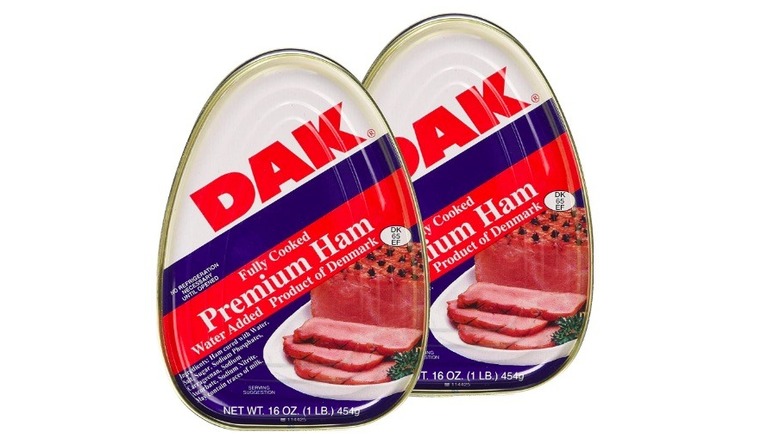The Untold Truth Of Canned Ham
We may receive a commission on purchases made from links.
There aren't many foods quite as quirky as canned ham. The protein-packed, preserved meat product is the last thing most of us would reach for in the grocery store these days. It's old-fashioned, it's honestly pretty bland, and it has a congealed, pale pink exterior that is far from Instagrammable, instead bringing to mind the jelly-laden, semi-homemade concoctions of the 1950s. But canned ham has history, and clearly it has staying power.
In all of canned ham's many guises — from clove-studded centerpiece to retro, ready-made side dish, to tasty sandwich topper, and so on — it has managed to resist the jokes and the changing times, quietly existing in the back of our pantries and the background of our culinary culture. So whether you have any plans to try it or not, we dug up everything you need to know about this mystery meat. This is the untold truth of canned ham.
Canned ham is nearly a century old
Canned ham was the invention of none other than George Hormel. If that name instantly sounds familiar, that's because you've been seeing the brand all over your grocery store your entire life. The same goes for your parents. The man who launched the company behind so many of our favorite food brands started it all with pork products near the turn of the 20th century (via Hormel). According to the company's official history, in 1926, Hormel invented the world's first canned ham. And from there, Hormel went on to develop a slew of other products that have been beloved for generations and are still recognized today, like Dinty Moore beef stew, canned chili, and the famous (or infamous, depending on how you look at it) Spam.
Almost 100 years later, appetites may have changed, but nostalgia persists, and you can still get canned ham from a variety of brands today (via Amazon).
Canned ham is Spam's predecessor, but they aren't exactly the same
When you think of canned ham, there's a good chance that a little tin can of Spam comes to mind, which makes sense: Hormel introduced the iconic product in 1937, just a few years after inventing the concept of canned ham (via Eater). The two are very similar, as they're both salty canned pork products. However, it's worth noting that Spam and canned ham aren't technically the same thing because according to the Spam website, the product actually contains a blend of pork and ham. Per the information on Walmart's website, Hormel's canned ham is just ham with some water added.
Cook's Info says that canned ham is usually a few pieces of ham compressed together into one solid piece. However, larger containers of canned ham may be one single cut of meat. This is different from Spam, which is made from ground meat. Of course, for the majority of us who don't happen to be canned meat connoisseurs, the difference probably doesn't matter too much.
Canned ham is safe to eat straight out of the can
A large part of the draw of canned ham, both back then and now (though for different reasons, perhaps), is that you can open it right up and eat it immediately. Of course, that doesn't mean there aren't also plenty of delicious ways to prepare canned ham on the stove, on the grill, and in the oven (more on that later), but the point is that you don't have to cook it beforehand because of the way it's prepared and packaged. Back in the day, this meant that meat could be enjoyed without the luxury of refrigeration. Today, it makes for probably one of the easiest snacks or breakfast sides you can find.
Canned ham is both cured — a preserving process where ham is infused with salt, sugar, and sodium nitrate which draws out the moisture while enhancing the meat's flavor — and then fully cooked and vacuum-sealed to lock out air before being packaged (via Good Housekeeping). Gelatin is often added as well, which mixes with juices from the ham during the cooking process.
There are two types of canned ham
Canned ham comes in both a pantry-stable and refrigerated variety (via Delighted Cooking). The former is the most common, and the one that we most often think of. Although a cool, dry place is the ideal place to store it, shelf-stable canned ham, much like SPAM, will pretty much be just fine anywhere until you're ready to eat it.
There's also canned ham that is meant to be kept in the refrigerator until it is opened and eaten. According to the USDA, these hams are still fully cooked, and therefore safe to eat, but they aren't processed long enough to become shelf-stable, so they have to stay cold to avoid spoiling. This leaves us wondering what the point of this refrigerated meat even is, since the appeal of canned ham is seemingly its convenience and long shelf life. But we don't make the meats.
Shelf stable canned ham will last for years
The biggest draw of canned ham, of course, is its shelf life. A can of pantry-stable ham, if unopened, will last for around two years, says the USDA. Other sources say a canned ham will keep in the pantry for up to five years (via Good Housekeeping). It's worth noting that even if it doesn't go bad, canned ham, like any canned food, can start to lose its quality of flavor and texture after three years as well, according to Hormel. So needless to say, maybe think twice before buying a can of ham you don't plan to eat within the next several years.
The canned hams that are meant to be kept in the refrigerator will keep for a pretty long time as well, though not nearly as long as their shelf-stable counterparts. The USDA estimates that you can keep these canned hams in the fridge for about six to nine months if they're kept sealed.
After it's open, canned ham needs to be eaten quickly
A closed tin of canned ham will last years. Once you open a canned ham, however, you better be prepared to eat it pretty quickly. After unsealing any can of ham, the USDA says it must be refrigerated after that and it needs to be eaten or thrown away within three to five days unless you freeze it.
While it might seem strange that canned ham has such a short shelf life after opening, it's due to the fact that the main thing preserving the ham was the anaerobic environment inside the closed can. As Reader's Digest explains, canned food is shelf-stable because the canning process kills the bacteria and other microorganisms that can make food rot. Once the seal is broken, those microorganisms can start invading the food once again. And as most of us have learned the hard way a time or two, consuming food-borne bacteria can quickly lead to getting sick.
It's not a good idea to freeze canned ham
If, for whatever reason, you decide you need to hang on to some canned ham past its (two year) expiration date, you might want to think again. While going the freezer route seems like the go-to move for extending the shelf life of most foods, it will likely have the opposite effect for canned ham. The University of Arizona explains that with any type of canned food, freezing temps may cause the contents of the can to expand, damaging the airtight seal that keeps the ham (or whatever) fresh. And in fact, Cook's Info says that freezing may cause the ham to rot inside the can.
There is one workaround. The USDA says that if ham is removed from the can first, it can be frozen, but hardly long enough to make it worth it. It will stay good in the freezer for another month or two tops and must be wrapped tightly in an airtight container (via RecipeTips.com).
There are lots of ways to cook canned ham
If opening up a cold container of canned ham and digging in is your jam, by all means enjoy to your heart's content. Otherwise, there are tons of ways to cook up, cook with, and transform a meager piece of canned ham into something far more tasty and exciting. Try adding a glaze to it and roasting in the oven (via Washington Post). You can also slice it up and fry it in a skillet — adding a crisp, caramelized texture and flavor — to serve up for breakfast alongside some eggs and toast.
If you're really feeling bold, try or whipping up some cheesy canned ham bites (via Food Network). Or more practically, you can dice up canned ham to throw into hashes, scrambles, soups, casseroles, and more. Basically, any recipe you might toss a little diced ham into, a can of ham would work, and you won't have to figure out what to do with the rest of a full-sized ham.
One of the most classic preparations is the old-fashioned baked ham
One of the most classic and long-beloved ways to enjoy canned ham is to bake it in the oven with all the glory of a traditionally roasted ham, minus the hassle. The old-fashioned way is to glaze the canned ham with a sweet, sticky sauce, top it with festive pineapple rings with maraschino cherry centers, and bake the whole thing for about an hour until it's hot and bubbly. Fancy without being pretentious, the dish was a staple of American dinner tables through the mid 20th century, especially around the holidays (via Taste).
If you want to try the vintage dish for yourself, Taste of Home has a version of the nostalgic, no-frills recipe, that couldn't be simpler. You can also give the retro recipe a kick with some chili, like this version from The Spruce Eats. Our own recipe for glazed pineapple ham, though it calls for a spiral-sliced variety, would also totally work with ham in a can.
Canned ham isn't as bad for you as you might think
Canned ham's reputation as a salty stalwart of the culinary underbelly might lead one to think that it's worse for you than it is. And don't get us wrong, it's canned, processed meat, and therefore not a great source of nutritional value. But it turns out that canned ham isn't quite as unhealthy as it might seem, mostly because there's not much to it – nothing more than ham, water, salt, sugar, and some preservatives (via Fooducate).
A recommended serving of canned ham only has about 100 calories and 4 grams of fat, based on a package of Hormel (via Fitbit). There's no sugar and no carbs in canned ham, and it's actually a great source of protein. The biggest health concern to keep in mind when it comes to canned ham is the sodium content. One package can have anywhere from 600 to more than 1,000 grams of sodium. That's nearly half a person's daily recommended salt intake, according to the CDC.










